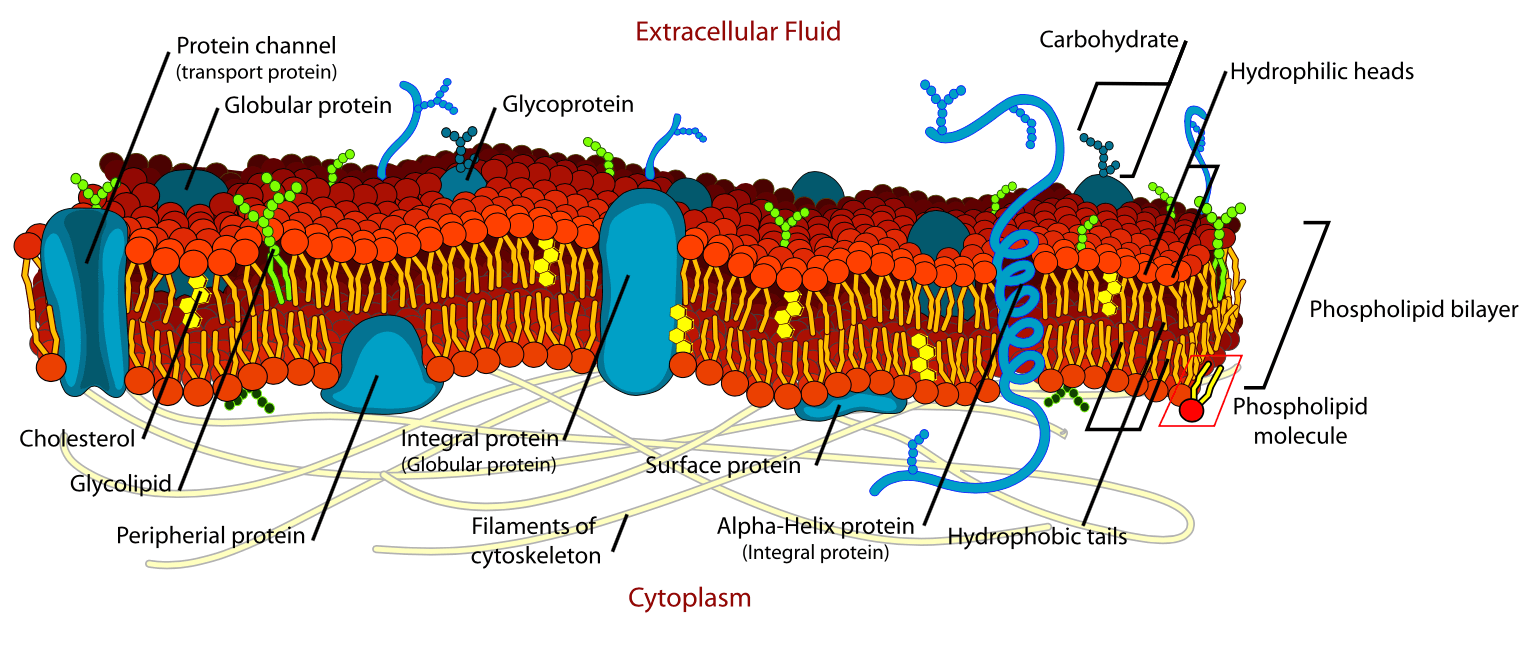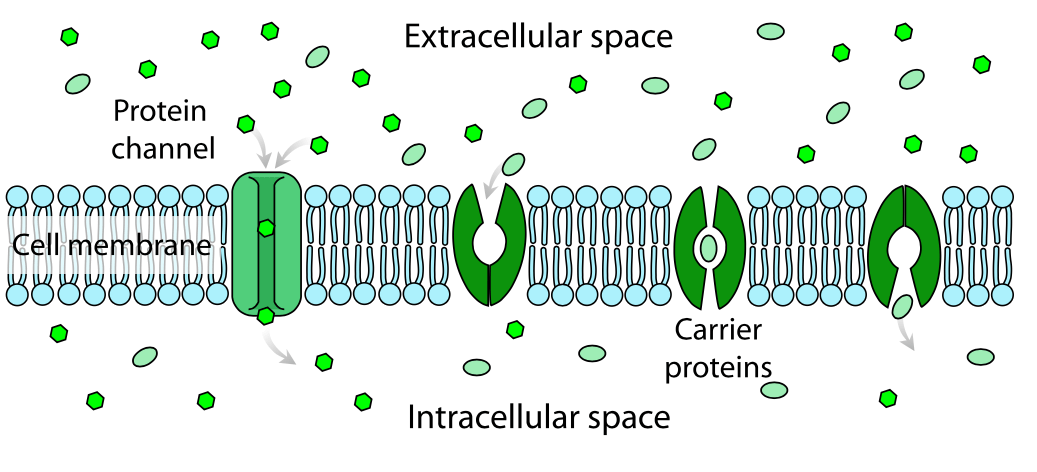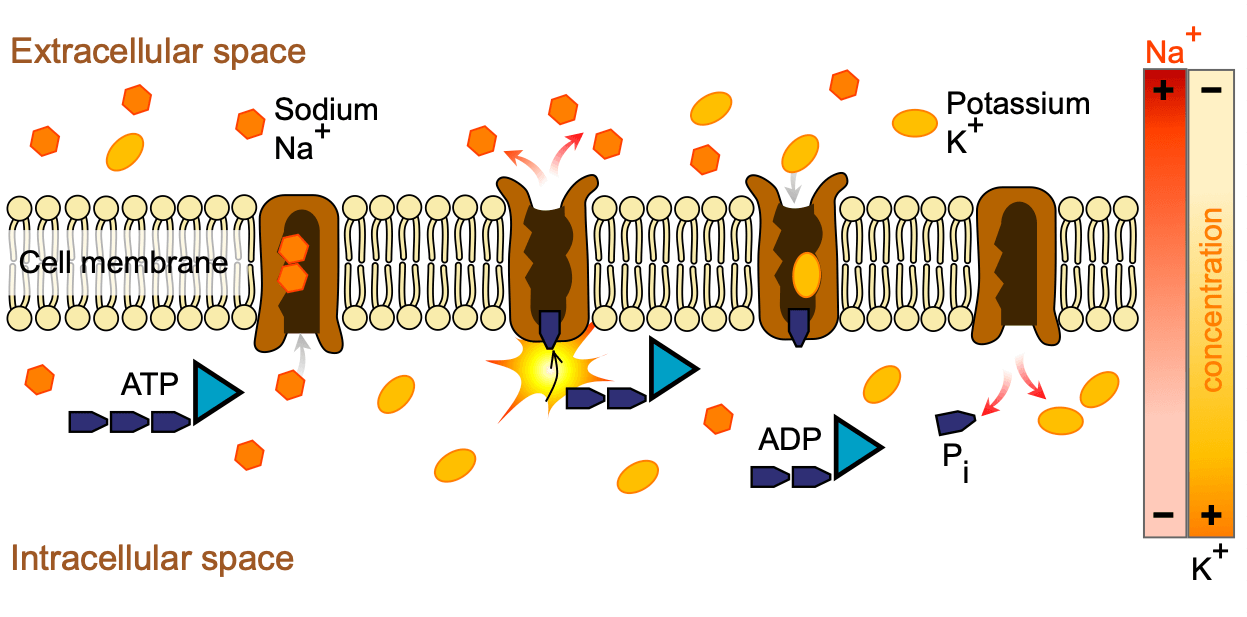In Part 1 of our ‘Cell Structure and Function’ series we learnt about basic cell structure and the organelles. We now move on to the cell membrane and membrane transport.
The cell membrane, also called the plasma membrane, physically separates the inside of the cell (the intracellular space) from the outside environment (the extracellular space). It defines the borders of the cell and surrounds and protects the cytoplasm and cell contents. The cell membrane also allows the cell to interact with its environment in a controlled manner.
Membrane structure
The cell membrane is composed of a double layer of phospholipids, which is referred to as a lipid bilayer. The phospholipids have a ‘water-loving’ (hydrophilic) head and a ‘water-fearing’ (hydrophobic) tail. The hydrophobic head is polar (charged) and can, therefore, dissolve in water. Conversely, the hydrophobic tail is non-polar (non-charged) and cannot dissolve in water.
In an aqueous environment, the polar heads attempt to form hydrogen bonds with the water, whereas the non-polar tails try to avoid the water. This results in the hydrophilic heads pointing away from the water and the hydrophobic tails point towards each another to ‘protect’ themselves from the water. The lipid bilayer, therefore, forms spontaneously due to the properties of the phospholipid molecules
Lipid molecules can diffuse freely within each layer, and the membrane is a fluid structure, with the lipid molecules continuously moving each other from side to side.
The structure of the lipid bilayer allows small, uncharged substances such as oxygen and carbon dioxide, and hydrophobic molecules such as lipids, to pass through the cell membrane, down their concentration gradient, by simple passive diffusion. Large polar molecules, however, such as glucose and amino acids, cannot cross through the membrane without the assistance of membrane proteins. Charged ions, such as sodium and potassium ions, are also unable to cross the cell membrane because of their charge.
Membrane proteins
The lipid bilayer forms the basis of the cell membrane, but it is peppered throughout with various proteins.
Structural proteins, as their name suggests, provide support to the membrane. These are associated with the inner lipid layer and create a flexible support scaffold for the cell called a cytoskeleton. An example of a structural protein is spectrin.
Membrane proteins are proteins that span the membrane and have hydrophilic and hydrophobic regions that allow them to fit into the cell membrane. These membrane proteins act as carrier proteins that enable the transmembrane movement of the large polar molecules that cannot pass through by diffusion.
Glycoproteins are a type of integral membrane protein that have attached carbohydrate molecules that extend into the extracellular matrix. The attached carbohydrate tags on glycoproteins aid in cell recognition.
Glycolipids are a type of membrane protein that have carbohydrate chains attached to phospholipids on the outside surface of the membrane. These act as recognition sites for specific chemicals and are essential in cell-to-cell attachment to form tissues.
GTP-binding proteins (G-proteins) are a type of intracellular membrane protein that is associated with cell signalling. They are enzymes that cleave guanosine triphosphate (GTP) to guanosine diphosphate (GDP) to activate or inhibit other membrane-bound signalling enzymes, such as adenylyl cyclase, which generates cyclic adenosine monophosphate (cAMP) from ATP. cAMP activates protein kinase enzymes within the cell to instigate changes in cell function via the phosphorylation of intracellular proteins.
G-protein-coupled receptors (GPCRs) are a type of transmembrane protein that penetrates the entire thickness of the lipid bilayer. GPCRs detect and bind signal molecules, which in turn activates one of the G-proteins to initiate a biological cascade which results in altered cellular activity. GPCRs mediate most of our physiological responses to neurotransmitters, hormones and environmental stimulants and also have great potential as therapeutic targets for a broad spectrum of disease.
A diagrammatic representation of the structure of the cell membrane is shown below:

Membrane transport proteins
There are two main classes of membrane transport proteins; carrier proteins (also known as transporter proteins) and channels. Carriers are not open to both the extracellular and intracellular environments at the same time. Either the inner gate or outer gate is open, not both.
There are three main types of carrier protein:
- Uniporters: these move a single type of molecule in one direction across a membrane only.
- Symporters: these move several different molecules in one direction across a membrane only.
- Antiporters: these can move different molecules in opposite directions.
Molecules move through membrane carriers by facilitated diffusion, which is the movement of molecules down a chemical concentration gradient. No energy is required for this to occur. Facilitated diffusion differs from passive diffusion in that the transported molecules do not dissolve in the lipid bilayer. An example of carrier proteins is the GLUT glucose transporter proteins.
In contrast to carrier proteins, channel proteins can be open to both the extracellular and intracellular environments simultaneously, forming a pore that allows molecules to diffuse through without interruption. The best-characterised channels are the ion channels, which mediate the passage of ions across the cell membrane. These channels are highly selective because the narrow pores in the channel restrict passage to ions of the appropriate size and charge.
The opening of ion channels is regulated by “gates” that transiently open in response to specific stimuli. Some channels (called ligand-gated channels) open in response to the binding of neurotransmitters or other signalling molecules; others (voltage-gated channels) open in response to changes in electric potential across the cell membrane. Flow through the channels is very rapid at a rate that is approximately a thousand times greater than the rate of transport by carrier proteins.
A diagrammatic representation of facilitated diffusion across a cell membrane is shown below. An ion channel is shown on the left, and a carrier protein on the right:

Movement of molecules across a cell membrane can also occur against a concentration gradient, from a region of low concentration to high concentration using an input of energy.
If the process uses chemical energy, such as adenosine triphosphate (ATP), it is called primary active transport. Secondary active transport involves the use of an electrochemical gradient and does not use energy produced in the cell. The movement of molecules is selective via the carrier proteins and can occur into or out of the cell.
The action of the Na-K ATPase (sodium pump) is an example of primary active transport. The pump is a transporter found in the outer plasma membrane of cells. For every single ATP consumed, it pumps 3 Na+ out of the cell and K+ into the cell, against the concentration gradients. The Na-K ATPase pump, therefore, maintains the gradient of a higher concentration of sodium extracellularly and a higher level of potassium intracellularly.
A diagrammatic representation of the sodium pump is shown below:

Header image used on licence from Shutterstock
Thank you to the joint editorial team of www.mrcemexamprep.net for this article.






